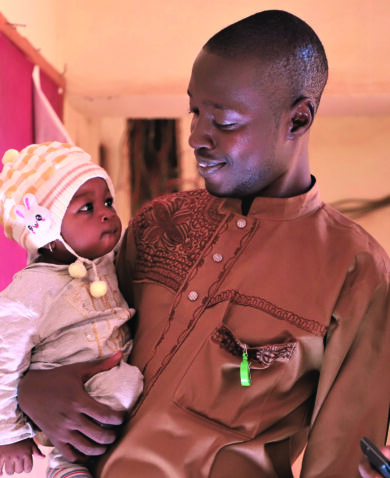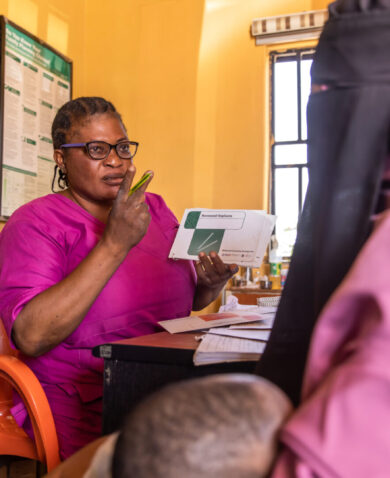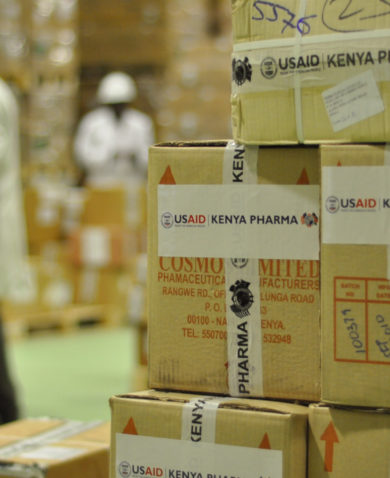
3 Questions with Teddy Manday on Using Data to Improve Access to HIV Treatment in DRC
April 23, 2024 | 5 Minute ReadA locally-developed online data visualization tool provides the Democratic Republic of the Congo (DRC) with up-to-date health commodity data to optimize the country's supply chain operations.
 In DRC, through the USAID-funded Global Health Supply Chain Program- Technical Assistance (GHSC-TA) Francophone Task Order (TO), Chemonics supported the development and implementation of a new logistics platform, InfoMED. Here, Teddy Manday, Country Director in DRC, shares some insights about InfoMED and its impact on improving HIV outcomes.
In DRC, through the USAID-funded Global Health Supply Chain Program- Technical Assistance (GHSC-TA) Francophone Task Order (TO), Chemonics supported the development and implementation of a new logistics platform, InfoMED. Here, Teddy Manday, Country Director in DRC, shares some insights about InfoMED and its impact on improving HIV outcomes.
1. What is InfoMED and how does it work? Why is this program a valuable tool to improve access to HIV treatment for patients in DRC?
InfoMED is an online platform and data visualization tool for stock logistics in DRC to access data and up-to-date information about health commodity stock levels and consumption data at all levels of the country’s supply chain. With InfoMED, users can see reports on the number of commodities available, consumption levels, when commodities are at risk of stockout, and which supplies are close to expiring.
InfoMED is compatible with the district health information system 2 (DHIS2), the main data collection tool used in DRC for managing logistics information. This allows for the collection of important data about stock management at health facilities and health zones, as well as at the Regional Distribution Centers and Federation of Medicines Supply and Distribution Center depots. Service providers and stock managers use the system to analyze monthly data on stock levels, including information on stock entries, consumption, losses, adjustments, expiration, and availability. This data is used to calculate the number of months of stock available and to determine how much to order. Users can also see which products are out of stock or overstocked and make decisions about supplies and reallocations accordingly.
2. The implementation of InfoMED was possible thanks to close collaboration between the project and the national government. How was InfoMED conceptualized and developed locally? How did it impact InfoMED’s success?

The successful deployment of InfoMED in DRC was made possible through a robust partnership between the project team and the DRC government, notably with the National Program for Essential Medicine and the Ministry of Health. This collaboration was critical because DRC lacked a digital system for managing logistical health data. Before InfoMED, health information, including medication consumption data, was tracked manually using paper records, and the DHIS2 did not provide logistics data at that time.
We wanted to have a system that would enable us to view logistics data in more or less real time from health facilities in the central offices of health zones, and other levels of the health system. USAID/DRC supported a study tour to Mali to learn from their experience setting up a data visualization system under the USAID Global Health Supply Chain Program-Procurement Supply Management project. This model effectively managed logistics data, inspiring us to adapt and enhance it for DRC. The GHSCA-TA Francophone Task Order team customized and expanded upon the Mali system, incorporating new features to better fit our context, resulting in the creation of InfoMED.
This system allowed us to improve:
- visibility into drug stocks, previously untracked,
- detailed data on drug consumption and patient treatment statistics,
- crucial support for informed decision-making processes.
InfoMED’s launch in October 2019 marked the beginning of its significant influence on DRC’s health system. Initially, its usage was limited, with only 10 of the country’s 26 provinces—those benefiting from USAID support—actively utilizing the system for reporting. This early adoption showcased a modest start, highlighting the system’s potential within a fraction of the national landscape.
Fast forward to the present, and the landscape has dramatically changed: all 26 provinces now actively report through InfoMED. This universal adoption is not just about numbers; it’s a testament to the system’s reliability and effectiveness. The responsiveness of the user community, particularly in identifying and reporting system bugs, underscores a proactive engagement that has expedited problem resolution and fostered a culture of quick decision-making. This shift represents a deeper, systemic change: stakeholders across the board, from government officials to private sector actors and civil society, recognize the value of real-time data access.

A tangible manifestation of InfoMED’s success is in its operational impact. Previously, distribution decisions were bottlenecked by the need for manual data collection from facilities. Now, InfoMED enables proactive insights into health consumption trends, allowing for efficient distribution planning without the lag of data collection.
The system’s influence extends beyond operational efficiencies. A noteworthy example includes the Global Fund’s inquiry into the disparities in logistics data visibility between USAID-supported provinces and those under its purview. This led to a sharing of best practices, inspired by InfoMED’s success in USAID provinces, with Global Fund aiming to replicate these successes elsewhere.
3. How do you think InfoMED helped prepare the country’s HIV supply chain for the future and what lessons have you learned in providing technical assistance through this project?
InfoMED has significantly enhanced the management of the HIV supply chain at the country level by providing a comprehensive platform for monitoring HIV product stocks. This system has allowed us to track the stock levels and average monthly consumption of each HIV product, a critical step for efficient inventory management.
Importantly, InfoMED offers detailed insights into consumption data, facilitating more accurate quantification exercises. This approach is highly valued as it aligns closely with actual needs, enabling us to make informed decisions about stock replenishment and distribution.
This platform’s capability extends to cross-referencing drug consumption with patient data, enabling us to verify the alignment between the drugs consumed and the number of patients treated. Such analysis is invaluable for identifying discrepancies, such as stockouts or surplus at health care facilities, thereby guiding strategic distribution and resupply efforts. It also, critically, allows health care providers to see patient data by treatment protocol, to allow providers to know where tests are available, and where medicines are available for patient usage.
With InfoMED, planning is not only reactive but also proactive. It informs future supply plans, helping to adjust orders based on actual stock needs. For instance, if we are overstocked, we can postpone incoming shipments, optimizing our inventory levels and reducing wastage.
InfoMED has already made substantial contributions to improving the HIV supply chain, from ensuring product availability to refining patient treatment plans. Its potential for future impact is immense, particularly with continued investment in resources, commitment from partners, and enhancements in data quality. Together, these efforts will further solidify InfoMED’s role as an essential tool for health system strengthening and patient care optimization.
Posts on the blog represent the views of the authors and do not necessarily represent the views of Chemonics.
Banner image caption: A health worker at a health facility in DRC uses InfoMED, the system showed in the screen, to track stock levels of health commodities in real-time, ensuring that these commodities are available for patients who need them. Credit: Arlette Bashizi.



























































